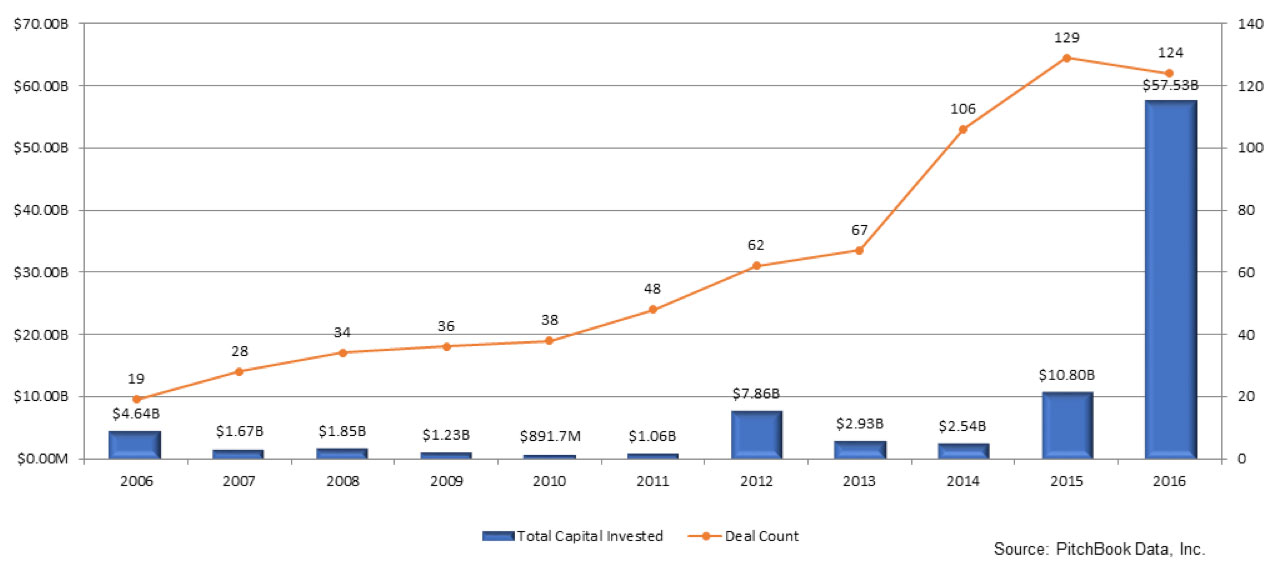European tech can benefit hugely from Asian investors refocusing away from the US
We think 2017 will be a watershed year for Asian investment into European tech. Perversely we think the most active ‘European’ destination will be the UK. There are several factors combining to set the stage for a potentially landmark year for Asian capital into Europe:
- Asian capital thinking twice before committing more money to the US – Much of the sentiment and rhetoric since the US election is anti-Chinese and, more generally, should concern any Asian corporate. There is a feeling Asian corporates have benefited too much from US trade, and this needs to be redressed. Irrespective of how true or not, the fact is Asian corporates and investors are less welcome in the US the next 4 years than in the last 8. They are also less needed. Significant private equity and the prospects of offshore corporate cash flowing back into the US offers the prospect of huge private liquidity. Finally, US tech valuations aren’t exactly cheap: they are at all-time highs in many sectors.
- There is a 25% discount on UK tech – A $/£ rate near $1.20 is near unprecedented on a trade-weighted basis. While currency doesn’t drive basic investment decisions, it does make previously-logical UK investments 25% cheaper than a few months ago. EU risks that drive this depressed rate are of little consequence to many Asian investors; they are interested in leveraging UK tech assets in Asia, not elsewhere in Europe. Hence the 25% discount is real for them.
- The number of ‘grown up’ European companies is far greater than 10 years ago – There are nearly 50 European tech ‘unicorns’ valued at $1B+, up sharply from even five years ago. European unicorns are much better developed than US counterparts; revenue averages $300m+ versus $100m+ for US unicorns. While these groups aren’t precisely comparable, the difference is indicative of a European trend away from hype valuations, resulting in performance driving value more than just potential. We see this mind-set having created dozens of sizeable and mature tech assets in Europe, making that sector much more investable than a decade ago.
- European late stage growth capital is a fraction of what’s needed, leaving a huge gap in the market – While a similar number of tech companies get initial funding in both Europe and the US, the funding gap is yawning in later stage rounds. For Series C and later rounds, total US capital invested in tech in 2016 was $26B, in Europe that number was less than $2B. As more European companies mature, this gap will be closed by Asian investors, as nature truly abhors a vacuum.
- Many emerging European tech leaders will need funding in 2017/18 – We see dozens of European tech companies that have been funded recently to achieve scale quickly, not necessarily to break-even. The result is that we believe an unprecedented number of quality tech companies in Europe will need at least one more significant funding round (e.g. $30m+) from 2017 onwards. While European VC has increased significantly in recent years, the capital requirements for these companies is happening faster than the local VC industry can mature to handle it. This funding gap will be filled in part by greater Asian capital.
- Asian corporates have already bought platform assets in Europe – According to PitchBook, 2015-16 saw unprecedented Asian M&A of platform assets in Europe which will be expanded through follow-on investment and acquisition. From ARM plc being acquired by Softbank, to Midea’s investment in German robotics firm Kuka, to Tencent acquiring Supercell, down to a broad range of $100m+ acquisitions completed or in progress, Asian corporates are building long term assets in Europe which will drive future capital inflow.
Asian Investment In European Tech $B (All Stages, Types)

- Much of European tech is already more international than the US, making adaptation for Asian markets easier and less risky – Because of smaller home markets European tech companies build platforms and models which are inherently more international than US counterparts. For example, in fin-tech European companies build multi-currency and multi-lingual capability in their products day one. European tech companies think nothing of creating multiple overseas operations early in their development, something US companies have little need to worry about. This results in European tech targets that are inherently much ‘safer’ to internationalise, in turn increasing their attractiveness.
Last year Asian capital into European tech reached an all-time high of $58B. We believe 2017-18 could see a doubling of that, entirely transforming the European tech ecosystem.
We believe ‘looking East’ from 2017 could be the greatest ever endorsement of the quality and value of European created-technology, and accelerate the development of the tech ecosystem far faster than it could ever develop by ‘looking West.’










